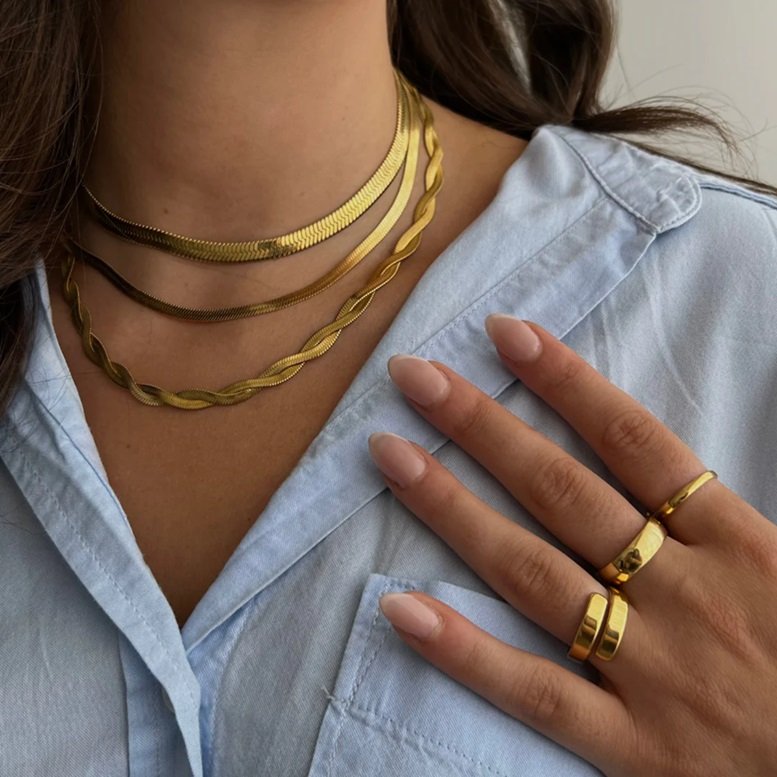Throughout history, rings have served as symbols of power, love, faith, and fashion. From ancient civilizations to the present day, rings have carried meaning far beyond their simple form. This historical journey explores the evolution of rings, the materials used to craft them, and their cultural significance. Whether crafted from gold, silver, or even more affordable materials, rings remain a timeless accessory in fashion and personal expression.
1. The Origins: Rings in Ancient Civilizations
Rings in Ancient Egypt
One of the earliest examples of ring use comes from Ancient Egypt, where rings were not only worn as decorative pieces but also as symbols of status and power. The Egyptians were known for creating rings from materials like gold and silver, often embedding them with precious stones such as lapis lazuli and turquoise. Rings with hieroglyphic inscriptions or images of gods were also popular, believed to offer protection to the wearer.
Signet rings were a hallmark of the Egyptian elite, serving both as personal adornments and official seals. The design of these rings was carefully crafted, with the wearer’s personal insignia engraved into the stone. This tradition was passed down through generations, illustrating the significance of rings in both personal and state affairs.
Rings in Ancient Greece and Rome
In ancient Greece, rings were often worn to honor the gods and were made from materials like iron and bronze. Greek rings frequently featured symbols of mythology, with designs representing gods, animals, and other sacred symbols.
The Romans continued this tradition but expanded the use of rings to signify social status and political authority. Wealthy Roman citizens would wear rings made of gold or silver, while the common classes used iron rings. For the Romans, rings were also symbolic of love and fidelity, and they are credited with popularizing the tradition of engagement rings—a tradition that continues today.
2. Rings in the Middle Ages: Symbols of Authority and Faith
Medieval Significance of Rings
During the Middle Ages, rings took on even more profound meanings, especially within religious and royal circles. Bishops and other high-ranking clergy members often wore rings that symbolized their spiritual authority, often with elaborate designs representing Christian symbols such as crosses or saints.
In Europe, royalty and nobility also wore rings as signs of wealth, power, and alliances. Rings were given as tokens of loyalty and trust, particularly in political and marriage arrangements. A notable development during this period was the use of rings as engagement tokens, with a growing association between rings and marriage vows. The practice of exchanging rings during a wedding ceremony became increasingly popular, and these early engagement rings were often simple bands made from gold.
The Rise of Gemstone Rings
By the late Middle Ages, rings adorned with gemstones became a popular trend among the wealthy. Diamonds, rubies, and emeralds were set into ornate bands, reflecting the wearer’s affluence and status. This era also saw the rise of engraved rings, often bearing personal mottos or religious scriptures to protect or inspire the wearer.
3. The Renaissance and Beyond: Rings as Fashion Statements
Rings in the Renaissance Era
The Renaissance brought a renewed interest in art and craftsmanship, and rings became more intricate and ornate during this period. Jewelry makers in Italy, France, and England developed advanced techniques to create highly detailed rings using precious metals and stones. Rings became valuable pieces of art, worn not only by royalty but also by the rising merchant class.
During this time, fashionable rings were designed to reflect personal tastes and social trends. Portrait rings, which featured miniature portraits of loved ones or significant figures, gained popularity. Additionally, rings with religious symbols continued to be important, often worn as a sign of piety.
Rings in the Georgian and Victorian Eras
By the Georgian era (1714–1837), rings had evolved into personal and romantic expressions. Mourning rings, worn to commemorate a deceased loved one, often featured dark stones like onyx or jet, along with sentimental engravings. In contrast, the Victorian era (1837–1901) saw an explosion of romanticism in ring designs. Queen Victoria’s love for her husband, Prince Albert, inspired a trend for heart-shaped and floral motifs in rings, which became immensely popular.
It was during the Victorian period that diamonds rose to prominence, especially after the discovery of diamond mines in South Africa. This made diamonds more accessible to the growing middle class, and the tradition of diamond engagement rings became firmly established.
4. The Modern Era: Rings for All Occasions
20th Century Rings: From Art Deco to Minimalism
The early 20th century saw a wide variety of ring styles, ranging from the geometric designs of the Art Deco era to the simpler, sleek designs that followed in the mid-century. Platinum became a popular material for rings during this time, known for its strength and ability to hold delicate diamond settings.
By the 1960s and 1970s, rings became bold statements of individuality, with large, colorful stones and experimental designs taking center stage. Designers began to move away from traditional gemstones, instead exploring unique materials and unconventional shapes.
Rings in the 21st Century: Affordable and Fashionable
Today, rings continue to play a central role in fashion, whether as part of formal attire or casual wear. While fine jewelry remains a symbol of luxury, there has been a significant rise in the demand for fashionable cheap rings that offer style without the hefty price tag. Modern advancements in materials like sterling silver, cubic zirconia, and synthetic gemstones have made it easier than ever to find trendy, affordable rings that mimic the look of high-end pieces.
Fashion rings today cater to a variety of tastes, from minimalist designs for everyday wear to bold statement rings perfect for making a splash at special events. Whether you’re seeking vintage-inspired designs or contemporary trends, rings remain a beloved accessory for all occasions.
Conclusion: Rings as Timeless Adornments
From the signet rings of ancient Egypt to the affordable and stylish options available today, rings have consistently served as powerful symbols of status, love, and personal expression. The evolution of ring design throughout history reflects not only changes in fashion but also societal values and technological advancements. Whether you prefer luxurious pieces or fashionable cheap rings, there’s a ring out there for every style, budget, and occasion.



